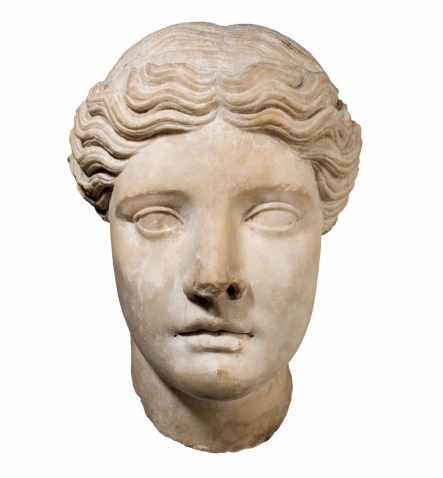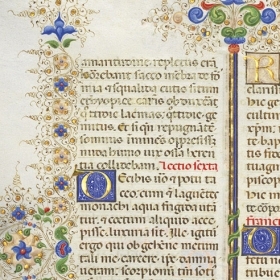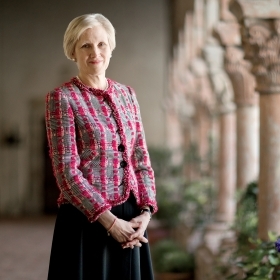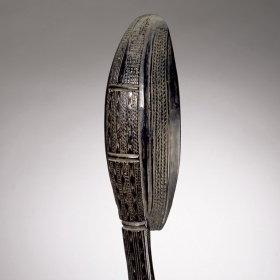When people envision classical Greek sculpture, they think of beautifully shaped marble heads, or the sinuously curved torsos of athletes and goddesses. With their mind’s eye, they fill in the missing body parts or the truncated head, but much of the puzzle remains. Fragments, by their very nature, can thwart attempts to discover their full story.
The Greek sculpture Head of a Goddess is a good example. The sheer size of the head suggests that it once belonged to a larger-than-life-size Greek sculpture, but there’s no way to know for certain. By comparing the Wellesley head with similar sculptures, it can be reasonably assumed that the complete work would have been quite large. (A sculpture of Juno in Boston’s Museum of Fine Arts measures more than 12 feet tall and weighs 13,000 pounds.) Such enormous figures would have come from temples or other sacred spaces.
Conjecture about its origins aside, the Head of a Goddess was a strategic acquisition when it was purchased by Wellesley in 1967, according to Meredith Fluke, who recently stepped down as Kemper Curator of Academic Exhibitions and Affairs at the Davis Museum. In the mid-1960s, the College’s art department was building its antiquities collection. Wellesley curators, like those at other institutions in mid-century, were attracted to architectural and sculptural fragments not only because they were easier to acquire than larger pieces, but also because they reflected the dichotomy of the era. The mid-20th century, especially post-World War II, was a time of both dismay and optimism. Broken objects “remained an ambivalent symbol of both destruction and hope,” Fluke says.
The Davis Museum recently explored the concept of fragmentation in the exhibition Fragment: A Museum’s Mid-Century Legacy. The show included not only Greek sculpture but also Egyptian figurines, African masks, and Baroque German sculpture. Each object shared the condition of having been removed from its original context, whether through age and dislocation or deliberate human interference. These fragments often had no clear history of ownership and few clues as to their origins.
Drawing together the threads of art history to answer questions about art objects is an important goal of a teaching museum like the Davis. By viewing fragments such as Head of a Goddess, students have an opportunity for firsthand study, rather than relying on photos in a book. Their observations, combined with research, can begin to piece together the mysteries of the past.








We ask that those who engage in Wellesley magazine's online community act with honesty, integrity, and respect. (Remember the honor code, alums?) We reserve the right to remove comments by impersonators or comments that are not civil and relevant to the subject at hand. By posting here, you are permitting Wellesley magazine to edit and republish your comment in all media. Please remember that all posts are public.